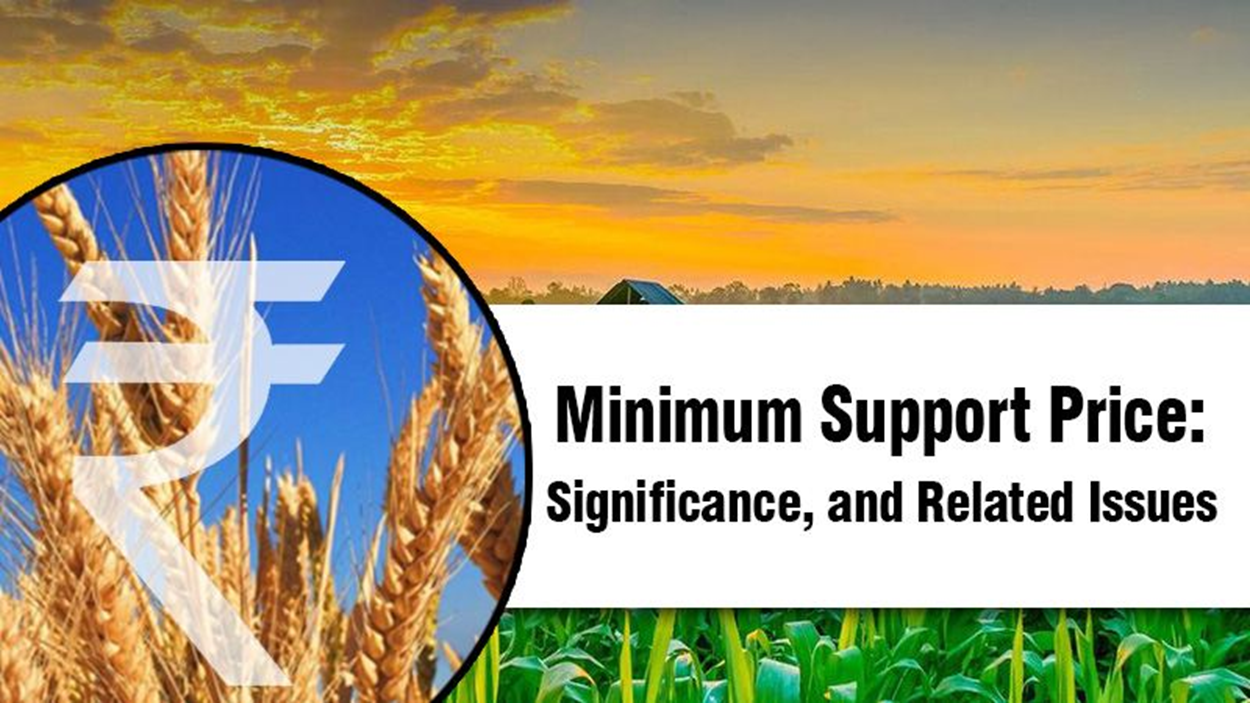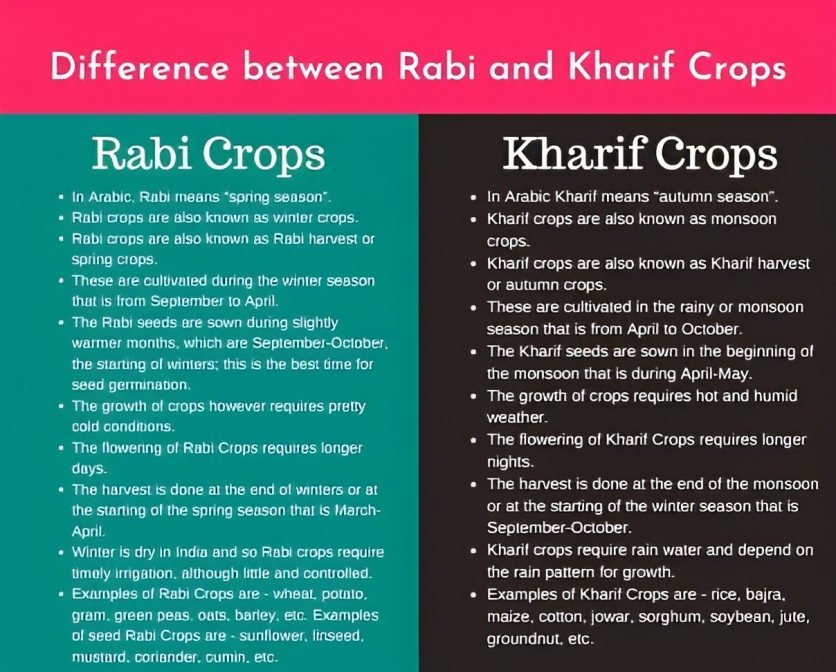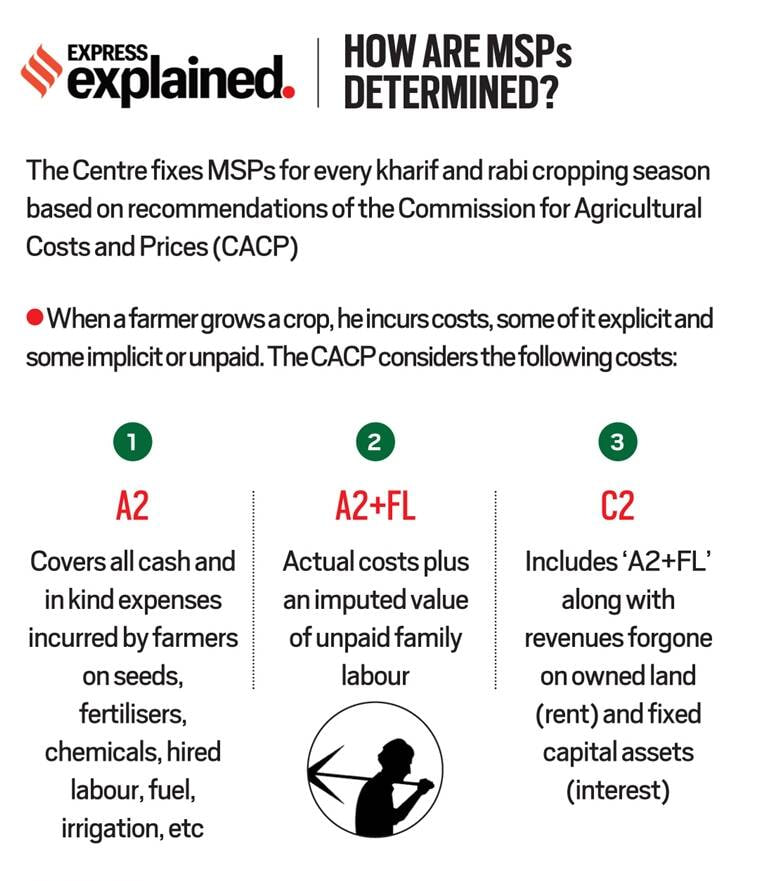
Copyright infringement not intended
Context: The Prime Minister has chaired the Cabinet Committee on Economic Affairs (CCEA) and approved the hike in the Minimum Support Prices (MSP) for all mandated Kharif Crops for Marketing Season 2023-24. This decision is aimed at ensuring remunerative prices to the growers for their produce and encouraging crop diversification.
Details
- The hike in MSP for Kharif Crops for Marketing Season 2023-24 is in accordance with the Union Budget 2018-19 announcement of fixing the MSP at a level of at least 1.5 times the All-India weighted average Cost of Production, intending to provide reasonably fair remuneration for the farmers.
- The estimated margin to farmers over their cost of production is expected to be highest in the case of bajra (82%) followed by tur (58%), soybean (52%) and urad (51%). For the rest of the crops, the margin to farmers over their cost of production is estimated to be at least 50%.
Kharif Crops
- Kharif crops are domesticated plants that are cultivated and harvested during the monsoon season, which lasts from June to November depending on the area. They are also known as monsoon crops or autumn crops.
- Kharif crops require good rainfall and a hot and humid climate for their growth. Some of the major Kharif crops in India are rice, maize, cotton, jowar, bajra, moong, urad, groundnut, soybean and sugarcane.
- Kharif crops are sown at the beginning of the first rains during the advent of the southwest monsoon season, and they are harvested at the end of the monsoon season (October–November).
- The sowing dates vary from region to region depending on the onset of monsoon. For example, in Kerala, where the monsoon arrives in May, Kharif crops are sown in May and June. In Maharashtra, Gujarat and Rajasthan, where the monsoon arrives in June, Kharif crops are sown in June and July.

Significance
- Kharif crops are important for food security and the economy, as they provide staple food grains, oilseeds, pulses, fruits and vegetables for millions of people.
- They contribute to the export earnings of these countries. For instance, India is the largest producer and exporter of rice in the world.
- Kharif crops provide raw materials for various industries such as textiles, sugar, edible oil and biofuel.
Productivity and Quality
- The productivity and quality of Kharif crops depend on the quantity and timing of rainfall as well as other factors such as soil fertility, pest and disease management, irrigation facilities and crop varieties.
- Too much or too little rainfall or rain at the wrong time may affect the yield and quality of Kharif crops. Therefore, farmers need to adopt suitable agronomic practices and technologies to cope with the uncertainties of monsoon.
Challenges faced by Kharif crop farmers are:
- Drought: Lack of adequate rainfall during the critical stages of crop growth may cause water stress and reduce crop yield. Drought may also affect soil moisture and nutrient availability for subsequent Rabi crops (winter crops).
- Flood: Excess rainfall may cause waterlogging and flooding of fields, which may damage crops or delay harvesting. Floods may also cause soil erosion and loss of nutrients.
- Pest and disease: High temperature and humidity during the monsoon season may favour the outbreak of various pests and diseases that may affect Kharif crops. For example, rice is susceptible to bacterial leaf blight, blast, brown spot and stem borer; cotton is prone to bollworms, aphids and leaf curl virus; sugarcane is vulnerable to red rot, wilt and smut.
- Weed: Rapid growth of weeds during the monsoon season may compete with Kharif crops for water, nutrients and light. Weeds may also harbour pests and diseases or interfere with harvesting operations.
- Climate change: The changing patterns of rainfall and temperature due to climate change may affect the sowing and harvesting dates of Kharif crops as well as their yield and quality. Climate change may also increase the frequency and intensity of droughts and floods.
To overcome these challenges, farmers need to adopt improved varieties of Kharif crops that are resistant or tolerant to drought, flood, pest and disease. They also need to use appropriate methods of soil conservation, water management, nutrient management, weed control, pest control and post-harvest management. Moreover, they need to diversify their cropping systems by intercropping or rotating Kharif crops with Rabi crops or other suitable crops to enhance soil health, crop productivity and income stability.

Minimum Support Prices (MSP)
- Minimum Support Prices (MSP) are a form of agricultural price intervention by the government of India to ensure remunerative prices for farmers and to protect them from market fluctuations.
- The MSP is announced for 22 crops by the government for certain crops before the sowing season, based on the recommendations of the Commission for Agricultural Costs and Prices (CACP).
- The government procures the crops from the farmers at the MSP or assures them of procurement if the market prices fall below the MSP.
- The MSP policy has been in existence since 1965 and has played a significant role in ensuring food security, enhancing agricultural production and income, and stabilizing prices.
- The MSP policy has contributed to the Green Revolution in India by incentivizing farmers to adopt high-yielding varieties of crops and modern inputs. It helped in maintaining buffer stocks of food grains and ensuring public distribution to the poor and vulnerable sections of society. It supported the growth of agro-based industries and rural employment.

The MSP policy has several features that distinguish it from other forms of price support
- It covers a wide range of crops, including cereals, pulses, oilseeds, cotton, sugarcane and some commercial crops.
- It is not a legal right for the farmers, but a discretionary decision of the government.
- It is not a uniform price across the country but varies according to the quality and location of the crop.
- It is not a fixed price for the entire season but can be revised by the government depending on the market situation.
The MSP policy also faces several challenges and limitations that need to be addressed. Some of these are:
- The MSP policy is not effective in reaching all the farmers, especially the small and marginal ones who lack access to procurement agencies and markets. According to a study by NITI Aayog, only 6% of farmers sell their produce at MSP.
- The MSP policy is biased towards certain crops, regions and states, leading to distortions in cropping patterns, resource allocation and environmental sustainability. For instance, rice and wheat account for more than 70% of the total procurement under MSP, while pulses and oilseeds are neglected. Similarly, Punjab and Haryana receive more than 50% of the total procurement under MSP, while eastern and northeastern states are left out.
- The MSP policy is costly and inefficient for both the government and the farmers. The government incurs a huge fiscal burden due to the procurement, storage and distribution of food grains under MSP. The farmers also face delays in payments, quality issues and transportation costs due to MSP.
- The MSP policy is not responsive to changing consumer preferences, demand-supply dynamics and global market conditions. The MSP is often set higher than the market prices, creating surpluses and export barriers. The MSP is also not aligned with the nutritional needs and dietary diversity of the population.
To overcome these challenges and make the MSP policy more effective and efficient, some possible reforms are:
Expanding the coverage of MSP
- Expanding the coverage of MSP to more crops, regions and farmers. This can be done by strengthening the existing procurement agencies such as the Food Corporation of India (FCI) and National Agricultural Cooperative Marketing Federation of India (NAFED), as well as creating new ones at the state and local levels.
- The government can also use digital platforms such as e-NAM (National Agriculture Market) to facilitate online trading and price discovery for farmers.
Aligning the MSP with the market prices
- Aligning the MSP with the market prices, demand-supply situation and global trends. This can be done by using scientific methods and data analysis to determine the MSPs for different crops and regions. The government can also adopt a dynamic pricing mechanism that adjusts the MSPs according to the changing market conditions.
Reducing the fiscal cost and improving the efficiency
- Reducing the fiscal cost and improving the efficiency of MSP operations. This can be done by rationalizing the procurement, storage and distribution system of food grains under MSP. The government can also promote alternative modes of price support such as direct income transfer, price deficiency payment or crop insurance for farmers.
Crop Diversification and environmental sustainability
- Promoting crop diversification and environmental sustainability through MSP. This can be done by incentivizing farmers to grow more pulses, oilseeds and nutri-cereals that have higher nutritional value and lower water requirements. The government can also link the MSPs with the quality standards and environmental norms for different crops.

Conclusion
- The MSP policy is a crucial instrument for ensuring food security, farmer welfare and rural development in India. However, it needs to be reformed and revamped to make it more effective, efficient and equitable for all stakeholders involved.
Must-Read Articles:
MSP: https://www.iasgyan.in/daily-current-affairs/msp-19
|
PRACTICE QUESTION
Q. Minimum Support Prices (MSP) are the prices at which the government guarantees to buy agricultural produce from farmers. MSP is intended to ensure a fair income for farmers and protect them from market fluctuations. However, MSP also faces some challenges, such as fiscal burden, distortion of market signals, environmental degradation and regional disparity. How can MSP be reformed to address these challenges and promote a more efficient and sustainable agricultural sector?
|
https://pib.gov.in/PressReleasePage.aspx?PRID=1930440













